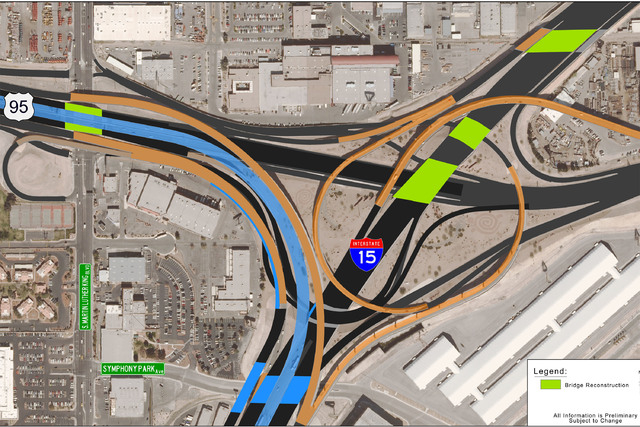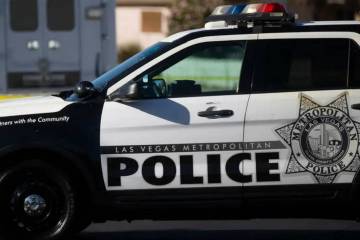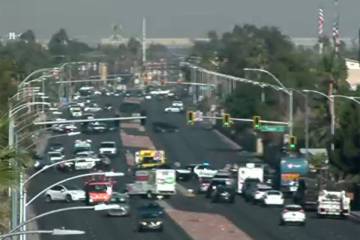Looming road work in Las Vegas instills commuter dread
Workers won’t put a shovel in the ground for more than a year, but residents and business people who live and work in the neighborhoods around the Spaghetti Bowl already are growing concerned about the state’s Project Neon transportation improvement project.
More than 100 people received an update from the Nevada Transportation Department Wednesday on the 3.7-mile, $1.5 billion project that is expected to take at least 20 years to complete.
The department has begun negotiations to purchase about 200 parcels for right-of-way along Interstate 15 and U.S. Highway 95. About 38 pieces already have been acquired to give workers the land needed to begin the first phase of the project.
Project manager Cole Mortensen said as details of the project’s financing are wrapped up, right-of-way is acquired and engineering is completed, motorists using the busiest freeway intersection in the state will see the first signs of construction in late 2015 or early 2016. Mortensen said the first phase of the project, which has a price tag of $700 million to $800 million, should be completed by 2019.
About 270,000 people —roughly 10 percent of the population of the state — use the Spaghetti Bowl every day.
While motorists who use the highway will share the pain of a massive construction project over a period of years, it’s the people who live and work in the area that face the most uncertainty.
They know they’ll be forced to move eventually. But when that will happen will be different for every individual as the state works through the acquisition and condemnation process.
Many of those attending Wednesday’s meeting asked questions Mortensen couldn’t answer: When will I have to move?
Some vented at Mortensen.
“I’ve been held a prisoner of the state of Nevada for over eight years,” said Don Bichelle, who spoke and stormed out of the meeting.
Mortensen referred people to the state’s acquisition specialist who is fielding each individual inquiry.
“I understand their frustration,” Mortensen said after the meeting. “I honestly don’t know the status of every transaction. In many of these cases, we’re negotiating with the owners of the property and the people here are tenants. In some instances, we may have completed the deal with the owner, but they don’t have to move out right away.”
Some of the business owners said the uncertainty was a hardship because they didn’t know whether to invest money in building repairs, like air conditioning, not knowing how long they’d be able to use it.
The owner of a beauty shop said he was having a hard time hiring stylists because prospective employees know they won’t be there long enough to build a clientele.
There’s also some pain ahead for motorists, although Mortensen said the state is committed to keeping three lanes of traffic open on I-15 at all times.
That seems like an impossible task because part of the project will include the replacement of four bridge structures within the Spaghetti Bowl interchange that have deteriorated over time. Mortensen said that likely would mean shifting traffic to the opposite side of the highway for a period. Some ramps in the interchange will be temporarily closed during construction.
The four overpass replacements will include the I-15 bridge over U.S. 95; the I-15 bridge over the Martin Luther King exit ramp off I-15; an I-15 bridge over a train spur; and the U.S. 95 bridge over Martin Luther King Boulevard.
But state officials are convinced the end result will be worthwhile.
The most visible part of Project Neon will be the construction of a two-lane flyover bridge that would be roughly parallel to and at the same elevation as the flyover that connects northbound I-15 traffic to northbound U.S. 95.
The new flyover ramp would move high-occupancy-vehicle traffic for both northbound I-15 to U.S. 95 and southbound U.S. 95 to southbound I-15.
Developing a network of HOV lanes throughout the valley is one of the driving forces of the project.
The short-term HOV system would run from U.S. 95, just north of the 215 Beltway to the Silverado Ranch Road exit of I-15. The department plans to convert the existing express lanes on I-15 into single HOV lane and one extra general purpose lane.
The long-term HOV strategy calls for lanes on I-15 from Lake Mead Boulevard to St. Rose Parkway, on U.S. 95 from just north of the Beltway to Interstate 215, on the entire length of I-215 and on the Beltway from Summerlin Parkway to I-215.
The busiest portion of the freeway system on U.S. 95 at Summerlin Parkway, to I-15 and I-215 to the McCarran International Airport connector would eventually have two HOV lanes in each direction and dedicated direct-access exits for HOV traffic to surface streets at 11 locations across the valley.
The long-term HOV system and some other surface improvements around the Spaghetti Bowl are the phases of work that won’t be completed for 20 years.
“We don’t have the financing for that lined up,” Mortensen said.
How to finance the first phase of Project Neon was only approved last week as the state Transportation Board decided to bypass a proposed public-private partnership financing plan in favor of traditional bonding.
Mortensen described the strategy change as getting better terms for a home mortgage. Paying on a long-term note eases the monthly payment, but you ultimately pay more money in the long run.
The state determined in February that it had developed a better credit rating as the economy improved, which led to last week’s decision to bond the project instead of pursuing a public-private partnership.
Contact reporter Richard N. Velotta at rvelotta@reviewjournal.com or 702-477-3893. Follow @RickVelotta on Twitter.

















